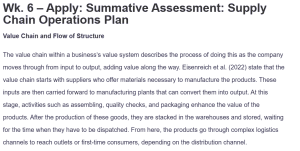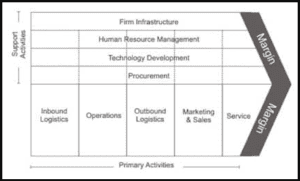Wk. 6 – Apply: Summative Assessment: Supply Chain Operations Plan
Value Chain and Flow of Structure
The value chain within a business’s value system describes the process of doing this as the company moves through from input to output, adding value along the way. Eisenreich et al. (2022) state that the value chain starts with suppliers who offer materials necessary to manufacture the products. These inputs are then carried forward to manufacturing plants that can convert them into output. At this stage, activities such as assembling, quality checks, and packaging enhance the value of the products. After the production of these goods, they are stacked in the warehouses and stored, waiting for the time when they have to be dispatched. From here, the products go through complex logistics channels to reach outlets or first-time consumers, depending on the distribution channel.
Inventory information in each stage of the value chain is managed because data systems track goods at that stage. The flow of structure is principally linear, from the raw material input to the consumer output but may comprise a few ‘loops’ for reusing, repairing, or reordering. Coordinated processes accompanied by the immediate exchange of information reduce problems in the chain. The value chain and flow of structure are illustrated below.
Inputs
In a supply chain, inputs are the necessary resources needed to generate commodities or services. Raw materials are the main input and can be anything from simple goods to intricate parts. These supplies are acquired from vendors and function as the fundamental components of manufacturing procedures. Human resources are essential for supplying the labor required for manufacturing, logistics, administrative duties, and raw materials. Maintaining quality and efficiency in operations and manufacturing requires skilled staff. Input in a supply chain is the element or factor required to create commodities or services. The principal resource is the raw material ranging from a basic commodity to a complex component. These are bought from suppliers and form the basics of production processes; they are also referred to as materials. Labor is critical as it is the human resource needed to provide labor in the production line, order and management of resources, and supply of other materials. The consistent delivery of quality and optimum operation and manufacturing is best achieved through the quality of staff.
Outputs
Outputs in a supply chain are the results and goods or services offered to the customers. It is a sign of enhancement of other steps from acquisition to production. The main product is the production of finished goods that are marketable and produced with the quality demanded by the market. These products are available in the market through other outlets or can be sold online to consumers. Apart from tangible products, organizations also offer services that may accompany the product adding value to the product. For example, product installation, maintenance, and customization options where the customer can add value.
The customer service system, which guarantees that clients receive assistance throughout their purchase process, is an essential component of the final product. Significantly, this covers both pre- and post-sale support. Post-purchase services might include warranty management, technical support, and product return management. Transparency is increased by enabling customers to trace the progress of their purchases using order tracking systems. Encouraging client happiness, handling feedback, and preserving solid connections all benefit from well-designed customer service structures. Essentially, this guarantees that the supply chain offers satisfied customers a great overall experience and product delivery.
Inventory Points and Forecasting
Inventory centers are strategic retail points along the supply chain for merchandise inventory, including raw materials, working inventory, and finished products. All these points ensure that the business can fulfill the customers’ demands while simultaneously pursuing operational expense efficiency. The purchasing requirement estimating techniques include predicting the amount of a product required in the market mainly by considering the historical data coupled with the market data and customer behavior. On the other hand, lead time forecasting is useful in predicting the time suppliers will likely take to bring in more raw materials to avoid waiting longer for supplies.
Sourcing Activities
Sourcing activities are critical for approving quality inputs at the right price and sustaining a robust value chain. Sourcing is commenced through supplier evaluation, whereby businesses assess potential suppliers. Most importantly, this helps the business in demanding supplies that can support its operations and production sessions. After that, contract negotiation reveals the terms agreed to by both partners on things such as price, delivery time, and the consequences in the event of non-adherence to these terms. Effective negotiation is a technique of bargaining whereby one can get far better conditions agreed upon all the time to establish a continuing relationship with the supplier. Supplier relation management is essential in the management of good relationships and, at the same time, the development of new products.
Risks
Supply chain risks have the potential to seriously impair business operations, resulting in delays, higher expenses, or a decline in consumer confidence. Supply risk is a significant concern, as it can result in delayed raw materials, frequently because of supplier problems such as unstable finances. Abrupt changes in the market might lower client demand, resulting in surplus inventory and financial losses. This is the source of demand hazards. Internal interruptions, including equipment breakdowns, a workforce shortage, and ineffective procedures that impede output, are examples of operational hazards. Natural catastrophes and other environmental hazards can influence production facilities and transit routes. Cross-border logistics can be made more difficult by geopolitical threats, including tariffs, trade restrictions, and political unrest. Finally, data breaches may jeopardize supply chain operations, making cybersecurity concerns an increasingly danger (Zamora et al., 2016).
Locations
Supply chain locations are strategically important for maximizing delivery, distribution, and manufacturing. To save money on transportation, manufacturing facilities should be situated close to important markets and raw materials suppliers. Strategic placement of distribution facilities near key client markets can save delivery times and expenses while improving service effectiveness. Target customers should be able to reach retail outlets, and lead times and risk management demands that supplier locations be considered. It’s also essential to be close to transportation hubs, like ports or roads, to guarantee prompt product flow across the supply chain.
Logistics
Organizing the effective flow of commodities along the supply chain requires a strong understanding of logistics. It includes outgoing logistics, which oversees delivering completed goods to consumers or merchants, and incoming logistics, which moves raw materials from suppliers to manufacturing facilities. Selecting the best kind of transportation relies on several variables, including distance, cost, and speed. Last-mile delivery concentrates on delivering goods to the client promptly and precisely, while effective warehousing makes sure that inventory is stored properly for speedy fulfillment. Logistics efficiency is increased by integrating technology, such as warehouse management systems and GPS tracking.
References
Eisenreich, A., Füller, J., Stuchtey, M., & Gimenez-Jimenez, D. (2022). Toward a circular value
Chain: Impact of the circular economy on a company’s value chain processes. Journal of
Cleaner Production, 378, 134375.
Zamora, E. A. (2016). Value chain analysis: A brief review. Asian Journal of Innovation and
Policy, 5(2), 116-128.
ORDER A PLAGIARISM-FREE PAPER HERE
We’ll write everything from scratch
Question
OPS/574: Creating Value Through Operations
Wk 6 – Apply: Summative Assessment: Supply Chain Operations Plan [due Day 7]
Top of Form
Bottom of Form
Exam Content
Top of Form
This assignment is intended to help you build a supply chain plan/diagram for a new business by analyzing factors that affect sourcing, logistics, metrics, suppliers, and risk.

Wk. 6 – Apply: Summative Assessment: Supply Chain Operations Plan
Create a diagram of the supply chain plan using one of the following tools:
-
- Excel
- PowerPoint
- Visio
- PictoGram
- Other faculty-approved platform
Write an 875-word analysis of the supply chain. Include the following:
-
- Value chain and flow of structure
- Inputs
- Outputs, including customer service structure
- Inventory points and forecasting
- Sourcing activities
- Risks
- Locations
- Logistics


